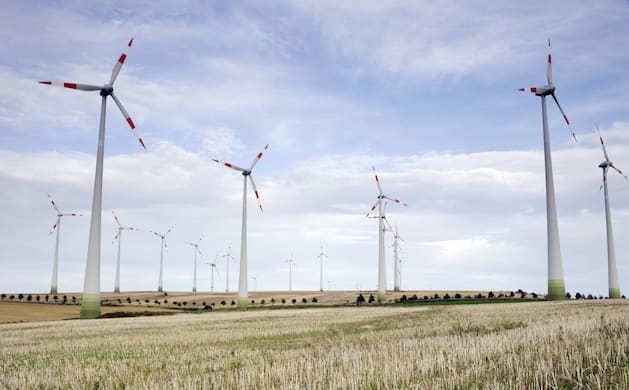Germany experiences the electricity price explosion. But some households in Saxony-Anhalt, among other places, don’t really care. You continue to pay only 30 cents per kilowatt hour – the reason being big, loud and flashing.
A large number of German households are currently receiving unwanted mail. Electricity tariffs are skyrocketing, and costs have often more than doubled. The trigger is the Russian war of aggression in Ukraine.
But not all citizens are affected by the price explosion. “I’ll pay 30 cents per kilowatt hour by the end of 2025 – like most of the villagers here,” explains Ralf Voigt to FOCUS online. He is honorary mayor in Dardesheim, a town with 750 inhabitants in western Saxony-Anhalt.
The municipalities of Badersleben and Rohrsheim are a few kilometers away, and they too pay the surprisingly low price. The reason for the cheap electricity tariff rises up about 150 meters between the three municipalities: a wind farm.
Around 700 meters as the crow flies from Dardesheim there are 37 wind turbines, they belong to the Druiberg wind farm. The operator of the plant, an energy company from North Rhine-Westphalia, sells part of the electricity generated to the residents of the three communities.
“Anyone who lives in the area and has the wind turbines in front of their noses every day should benefit from it,” says Thomas Radach, manager of the wind farm, in an interview with “Spiegel”. Customers pay 30 cents per kilowatt hour, plus a basic fee of ten euros per month. According to the comparison portal Verivox, that is 11.4 cents less than the national average for new customers (as of January 3rd, 2023). At this price, a two-person household saves several 100 euros in electricity costs per year – even with the electricity price brake.
It is even cheaper for residents if they use private electric car charging stations or heat pumps. Here it is only 24 cents per kilowatt hour.
Anyone who knows which devices at home consume how much electricity can make targeted savings. Our e-paper shows which devices consume how much electricity for all common household appliances, from ovens and stoves to refrigerators and washing machines to TVs and WLAN routers. There are also a number of instant power-saving tips.
With the offer, which will run until the end of 2025, the operator wants to increase local acceptance of the system. “The residents are surrounded by constant noise and nightly flashing lights, so we can give something back,” says Voigt, who also works as the project manager for the wind farm.
The model, which is intended to involve the residents, is particularly effective in the crisis. The electricity is generated cheaply, but sold at high prices on the electricity exchanges. “We simply take the money from the rich proceeds that we received and use it to support the additional costs for our citizens. Everything that goes over the necessary 30 cents is capped and paid for by us,” says Mayor Voigt. However, only those people who live directly in Dardesheim, Badersleben or Rohrsheim benefit from this.
Project manager Voigt has negotiated a quota of three million kilowatt hours of electricity a year with the energy company, which can be sold at a reduced price. Therefore, the amount is not enough to supply other towns in the Harz Mountains – they pay the prices that apply on the market.
Dardesheim, Badersleben and Rohrsheim also benefit in another way: the energy supplier leaves part of the added value on site. About one percent of the yield from the wind farm – around 70,000 to 80,000 euros per year – has been flowing back to Dardesheim alone for years. The money will be invested in the expansion of the infrastructure in particular.
The federal government plans to generate 65 percent of our electricity from alternative energy sources by 2030 – with increasing electricity consumption. It’s currently around 40 percent. So that this plan can be put into practice, the people who live right next to it must be convinced of the expansion of wind and solar parks.
So far, the expansion of wind energy has been sluggish, sometimes due to the so-called “NIMBYs” (“Not in my Backyard” factions). Many citizens in the country do not see why they of all people have to carry the necessary energy transition measures and have a wind turbine in their “backyard” or even right in front of the terrace. But not only because of the changed landscape do many Germans have reservations, but also concerns about risks to their own health or endangered animal species fuel rejection.
Lawsuits that slow down or even prevent the construction of wind farms are not uncommon. Wind farm operators are therefore increasingly under pressure to win the favor of local residents – cheap electricity tariffs are well received.
The aspect of purchasing clean electricity that was produced right on your doorstep is also becoming increasingly attractive. The model that is practiced in Dardesheim, Badersleben and Rohrsheim is therefore not an isolated case.
In Mecklenburg-Western Pomerania, for example, the so-called “Citizens and Community Participation Act” applies. With this initiative, the state government wants to oblige project developers of new wind farms to set up an investment company and to give shares of at least 20 percent to immediate neighbors within a five-kilometer radius and to the affected communities “It’s about getting the local people more involved in the projects and ensuring regional value creation,” says Olaf Fiesel, Head of Department in the Energy Ministry of Mecklenburg-Western Pomerania.















